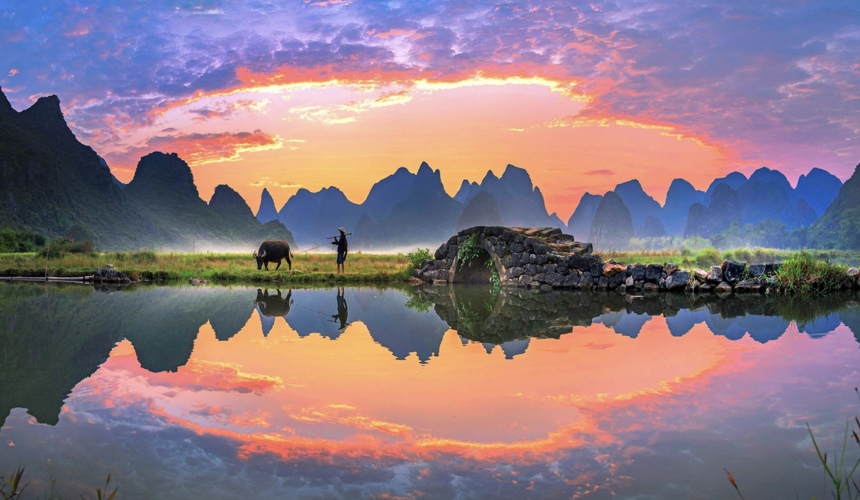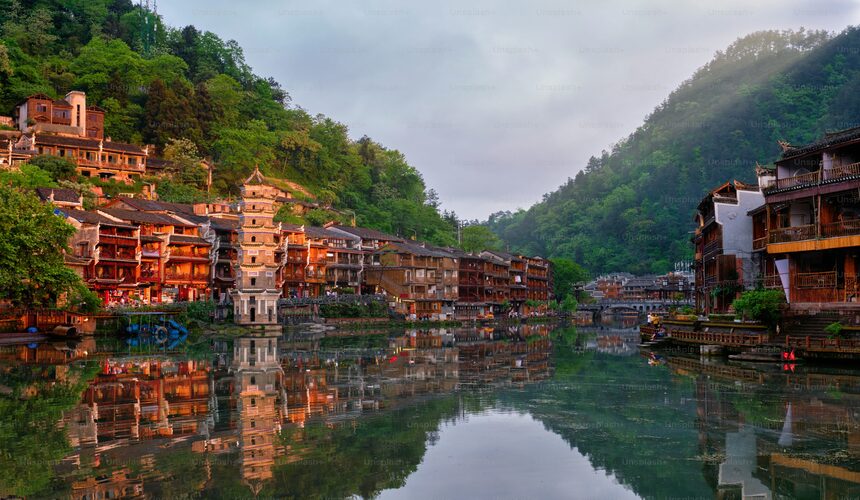
First Time in Xinjiang? Experience the Best of the Silk Road
Tucked away in the far northwest of China, Xinjiang. This is a land of breathtaking contrasts where snow-capped mountains meet vast deserts. Plus, the ancient Silk Road cities pulse with the rhythms of modern life. For first-time travelers, Xinjiang offers an unforgettable experience that feels worlds apart from the rest of China.
Once a vital hub on the ancient Silk Road, Xinjiang has long served as a cultural crossroads between East and West. Today, it remains a treasure trove of history, tradition, and natural beauty. You can wander through the maze-like alleys of Kashgar’s Old Town, marvel at the ruins of Turpan’s ancient cities, or gaze at the mirror-like waters of Karakul Lake. Every stop along the way tells a story of ancient trade.
This guide will present you with the highlights of a first-time visit to Xinjiang, offering a glimpse into must-visit destinations, local flavors, and practical travel tips. Ready to explore one of China’s most captivating regions? Let’s begin your Silk Road journey.
1. Top Places to Visit Along the Silk Road
Urumqi: Gateway to Xinjiang
Urumqi, the capital of Xinjiang. It is a modern city and a practical base for Silk Road explorations. Visit the Xinjiang Regional Museum, home to well-preserved ancient mummies and Silk Road artifacts that reveal the region’s multiethnic past. Stroll through Erdaoqiao Bazaar for local snacks and souvenirs. This city serves as a dynamic starting point with solid infrastructure and transportation links.
- Xinjiang Regional Museum: Famous for Silk Road mummies and cultural exhibits.
- Erdaoqiao International Bazaar: A marketplace for ethnic goods, spices, and textiles.
- Red Hill (Hong Shan) Park: A central city park with views over Urumqi.
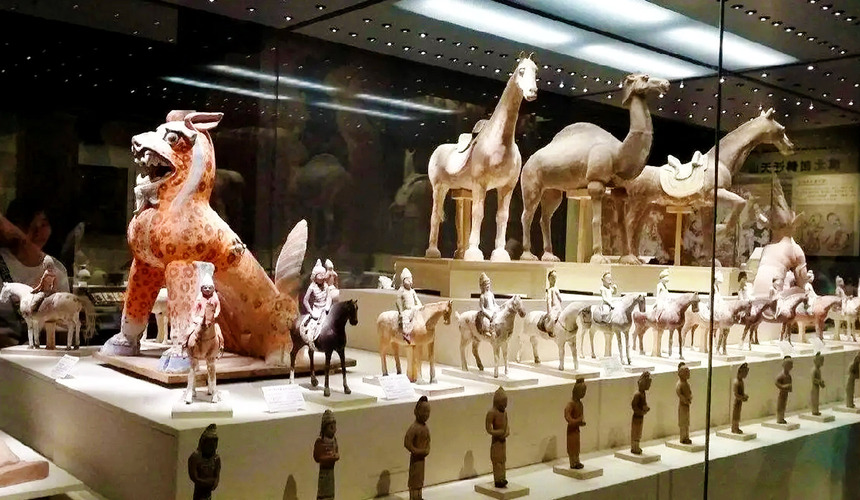
Kashgar: The Cultural Heart of the Silk Road
Kashgar is one of the most iconic Silk Road cities in China. Its ancient Old Town preserves centuries of Uyghur culture. Therefore, you can find mud-brick houses, narrow alleys, and local teahouses. The bustling Sunday Livestock Market is where traders gather from across Central Asia. This desert city offers a unique blend of Islamic architecture and multicultural heritage, making it the perfect introduction to Xinjiang’s Silk Road legacy.
- Id Kah Mosque: The largest mosque in China, central to Uyghur spiritual life.
- Kashgar Old Town: Explore mud-brick homes, cobbled alleys, and local crafts.
- Sunday Livestock Market: A lively and authentic Central Asian trading tradition.
- Apak Hoja Mausoleum: A stunning example of Islamic architecture and tiled design.
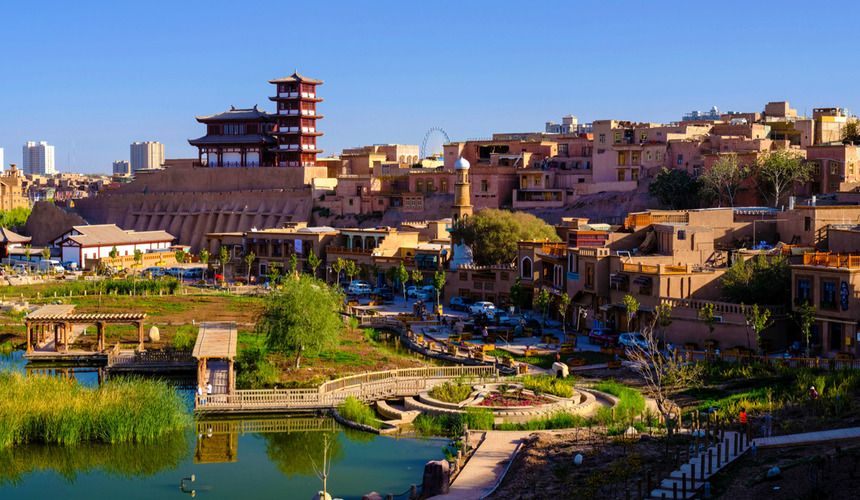
Karakul Lake: Scenic Beauty on the Pamir Plateau
Situated at over 3,600 meters above sea level. Karakul Lake is a glacial gem along the Karakoram Highway near Tashkurgan. Surrounded by snow-draped peaks like Muztagh Ata, the lake’s mirror-like surface offers postcard-perfect reflections. It’s a peaceful spot where Kyrgyz nomads graze their livestock. For your special experience, you can enjoy yak rides or stay in a traditional yurt.
- Karakul Lake Viewpoint: Marvel at reflections of Muztagh Ata and Kongur peaks.
- Yurt Stay Experience: Sleep like a nomad with Kyrgyz families by the lake.
- Karakoram Highway: One of the most scenic drives in the world.
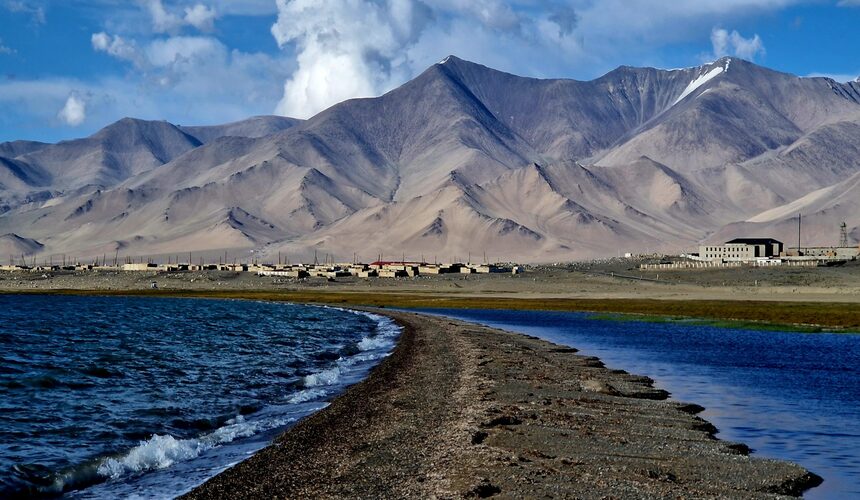
Turpan: Desert Oasis of Ancient Civilizations
Turpan lies in one of the world’s lowest and hottest depressions. Visit the Jiaohe and Gaochang ruins, once-thriving desert cities that now whisper stories of past empires. Learn about ancient irrigation at the Karez system, and stroll through lush grape valleys. Don’t miss the iconic Flaming Mountains, glowing red under the sun. Turpan will show you a thriving oasis full of culture, archaeology, and unforgettable desert landscapes.
- Jiaohe Ancient City: A remarkably preserved earthen city from 2,000 years ago.
- Gaochang Ruins: Remnants of a bustling Silk Road trading center.
- Karez Water System: Ingenious ancient underground canals that irrigated the desert.
- Flaming Mountains: Famous for red sandstone cliffs.
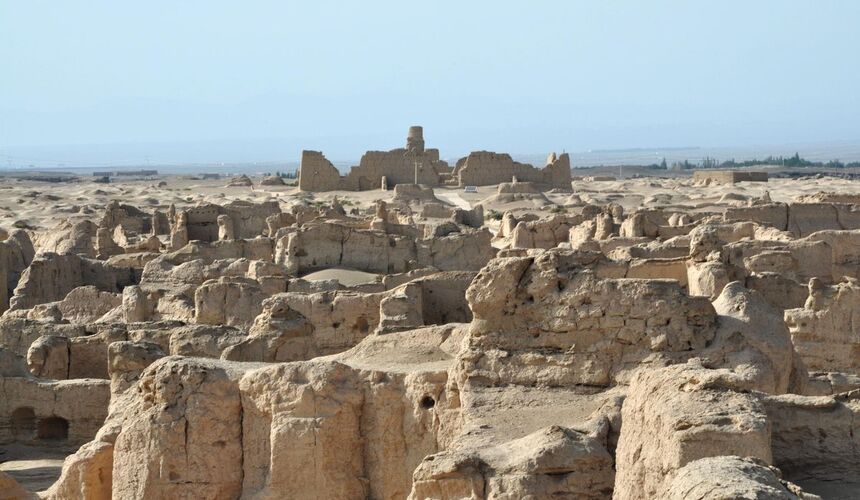
Kuqa: Historical Buddhist Center
Kuqa (Kucha) was once a major center of Buddhism along the northern Silk Road. The Kizil Thousand-Buddha Caves collect some of China’s oldest grottoes. Features vibrant murals dating back to the 3rd century. You can visit the Tianshan Grand Canyon for red rock scenery. Or explore the Kuqa Mosque to admire a blend of Islamic and Central Asian architecture. Kuqa offers a quieter and more spiritual side of Xinjiang.
- Kizil Thousand-Buddha Caves: Colorful Buddhist murals dating back to the 3rd century.
- Kuqa Grand Mosque: An architectural blend of Central Asian and Islamic styles.
- Tianshan Grand Canyon: Dramatic red sandstone formations are ideal for hiking and photos.
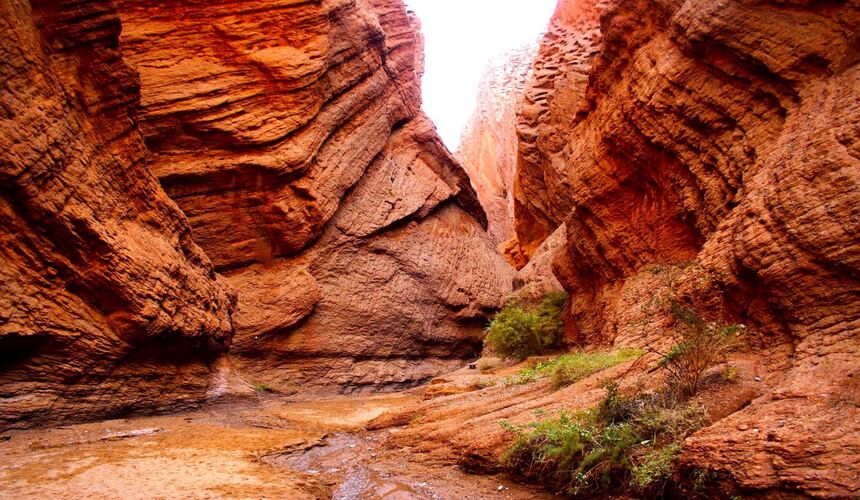
Hotan: Silk and Jade on the Southern Route
Hotan (or Hetian) is a desert city with a rich Silk Road legacy tied to silk production, such as jade carving and carpet weaving. Explore local workshops to see artisans practicing centuries-old crafts. Visit the Hotan Museum and Night Market, and take a walk along the edge of the Taklamakan Desert. Hotan gives you a hands-on glimpse of traditional Uyghur life and Silk Road commerce far from the more developed northern route.’
- Hotan Night Market: Local street food with Uyghur music.
- Hotan Museum: Artifacts from the Silk Road trade and ancient Hotan culture.
- Atlas Silk Factory: Watch traditional silk-making in action.
- White Jade River: Source of the region’s prized jade.
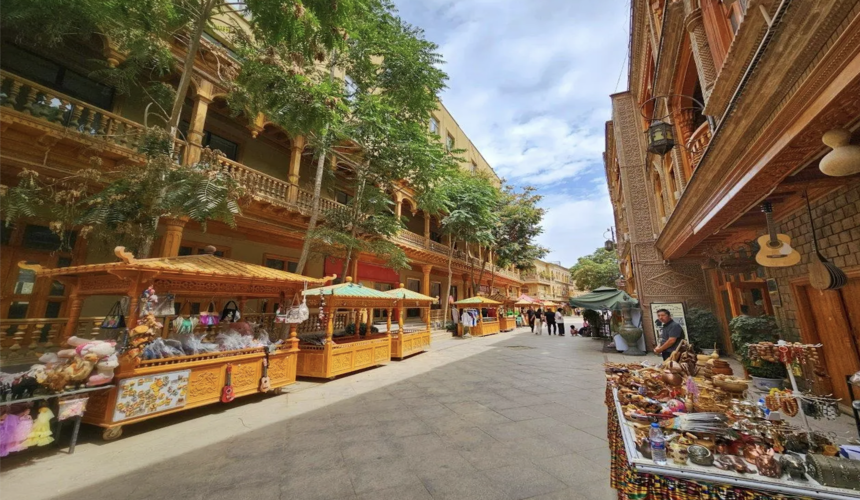
Tashkurgan: Where China Meets Central Asia
Tashkurgan sits on the Pamir Plateau near the border with Tajikistan and Pakistan. Therefore, it is one of the Silk Road’s most spectacular and remote outposts. Home to the Tajik ethnic minority, this highland town offers rich culture and majestic scenery. Explore the Stone Fortress standing over 2,000 years and admire sweeping views of yak-dotted meadows. Tashkurgan is perfect for travelers seeking both history and untouched natural beauty in a truly unique setting.
- Stone Fortress (Tashkurgan Fort): Ancient ruins with panoramic views of the plateau.
- Golden Grassland: A peaceful valley surrounded by snowy peaks.
- Tajik Ethnic Culture Museum: Learn about the lifestyle of local highland communities.
- Khunjerab Pass: The highest border crossing in the world (China–Pakistan border).
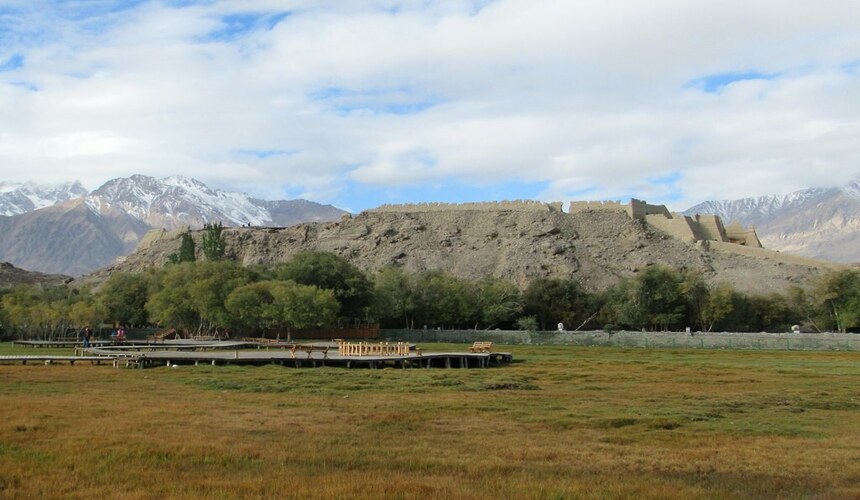
2. When to visit Xinjiang?
Spring (April–June)
Spring brings blooming apricot flowers in Yili and mild weather across the region. It’s a great time for sightseeing, hiking, and enjoying the desert oases before the summer heat arrives.
- Pros: Mild weather, blooming flowers, ideal for hiking.
- Cons: Occasional sandstorms; some areas still thawing.
- Temperature: 10°C–25°C (50°F–77°F)
Summer (July–August)
The best time to visit the grasslands of Narat and Sayram Lake. Expect hot temperatures in southern cities like Turpan, but cooler weather in mountain regions makes for perfect highland escapes.
- Pros: Cool mountain retreats, festivals, and alpine lakes.
- Cons: Hot in cities like Turpan (up to 45°C), crowded in tourist spots.
- Temperature: 20°C–35°C (68°F–95°F); Turpan up to 45°C (113°F)
Autumn (September–October)
Ideal for photography because the poplar trees turn golden, harvest festivals begin, and temperatures are comfortable. This is one of the most scenic and traveler-friendly seasons in Xinjiang.
- Pros: Best season for scenery, fewer crowds, great harvest foods.
- Cons: Short season; weather cools quickly in October.
- Temperature: 8°C–22°C (46°F–72°F)
Winter (November–March)
Cold but magical. Explore snow-covered landscapes, ski in Altay, or experience Uyghur New Year festivities. Fewer tourists and lower prices make winter appealing for the adventurous.
- Pros: Snowy landscapes, skiing in Altay, fewer tourists.
- Cons: Harsh cold, some sites closed, limited transport in remote areas.
- Temperature: -20°C to 5°C (-4°F to 41°F)
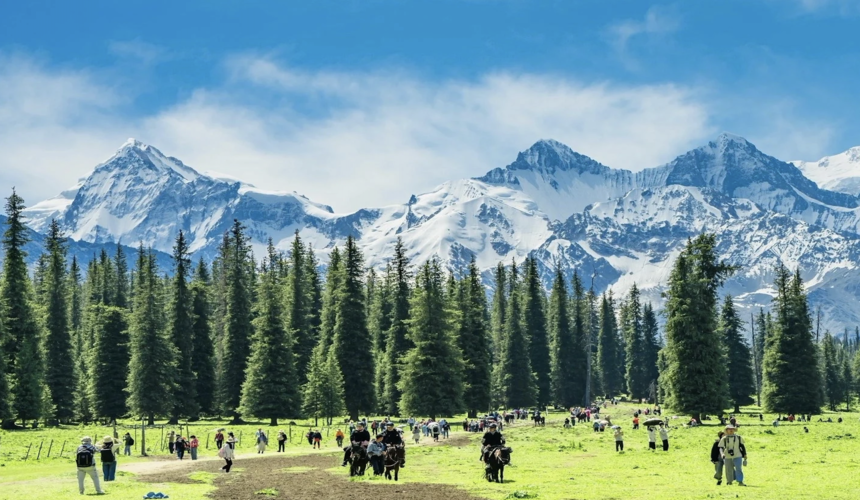
3. Why does Xinjiang need to be your next destination?
- Silk Road History: Xinjiang was a key hub on the ancient Silk Road. The route linked cultures, goods, and ideas between East and West.
- Diverse Ethnic Cultures: Home to Uyghur, Kazakh, Tajik, and more. Xinjiang offers rich traditions, music, languages, and lifestyles rarely seen elsewhere in China.
- Epic Landscapes: From deserts and grasslands to snow-capped mountains, Xinjiang’s natural scenery is vast and incredibly photogenic.
- Authentic Food Experience: Try lamb skewers, hand-pulled noodles, naan, and dried fruits. You can enjoy a flavorful blend of Central Asian and Chinese cuisine.
- Ancient Cities and Ruins: Visit historic sites like Jiaohe, Gaochang and Kashgar’s Old Town. Places where ancient walls and stories still stand.
- Vibrant Markets and Bazaars: Colorful local markets showcase spices, textiles, handicrafts, and the daily life of Silk Road descendants.
- Off-the-Beaten-Path Adventure: Far from China’s major tourist trails, Xinjiang offers raw and authentic experiences for travelers.

4. Essential Travel Tips for Visiting Xinjiang’s Silk Road
- Bring Your Passport Everywhere: Security is strict in Xinjiang. You’ll need to show your passport at checkpoints, train stations, hotels, and even some public areas. Always carry it with you.
- Download Offline Maps and VPN: Many Western apps and websites are restricted in China. Use Baidu Maps or download offline Google Maps, and install a VPN before arrival if you want to access blocked services. ( Read more: 10 Apps you need for travel in China )
- Dress Modestly and Respect Local Culture: Xinjiang is home to many Muslim communities. Wear modest clothing, especially in mosques or conservative towns.
- Expect Long Distances: Xinjiang is huge. Cities and attractions can be hundreds of kilometers apart. Plan ahead, allow buffer time, and consider overnight trains or flights to save time.
- Stay Hydrated and Prepare for Climate Swings: From desert heat in Turpan to chilly nights in Tashkurgan, the weather varies greatly. Pack layers, sunscreen, and always carry water.
- Book Hotels in Advance: Not all accommodations accept foreign travelers. Please double-check before you book.
- Try Local Food: Don’t miss Uyghur noodles, lamb kebabs, and naan, but take care with street food if you have a sensitive stomach. Avoid tap water, stick to bottled.
- Plan Around Festivals and Holidays: Major Islamic holidays (like Eid) or Chinese national holidays can affect opening hours and transport. Check local calendars before your trip.
- Cash and Mobile Payment: Mobile payments like Alipay and WeChat Pay are widely used, but not always accessible to foreigners. Bring some cash (RMB), especially in smaller towns. ( Read more: Payment guide in China )
If you are planning to deep dive into Silk Road history, we hope this guide gives you a brief start. But every traveler is different and that’s where we come in. Chat with one of our friendly local travel consultants on WhatsApp: +86 187 2197 8867 or email: [email protected] for personalized itineraries. Let us help make your first time visiting Xinjiang smooth and unforgettable!


